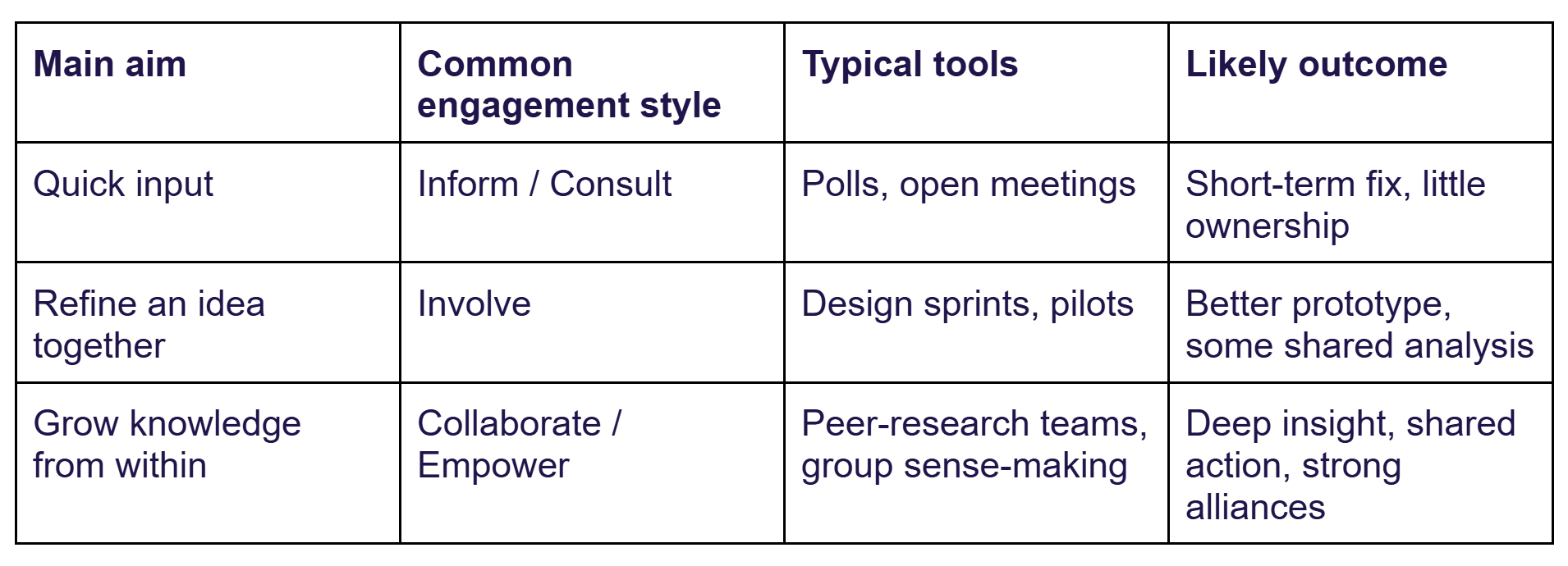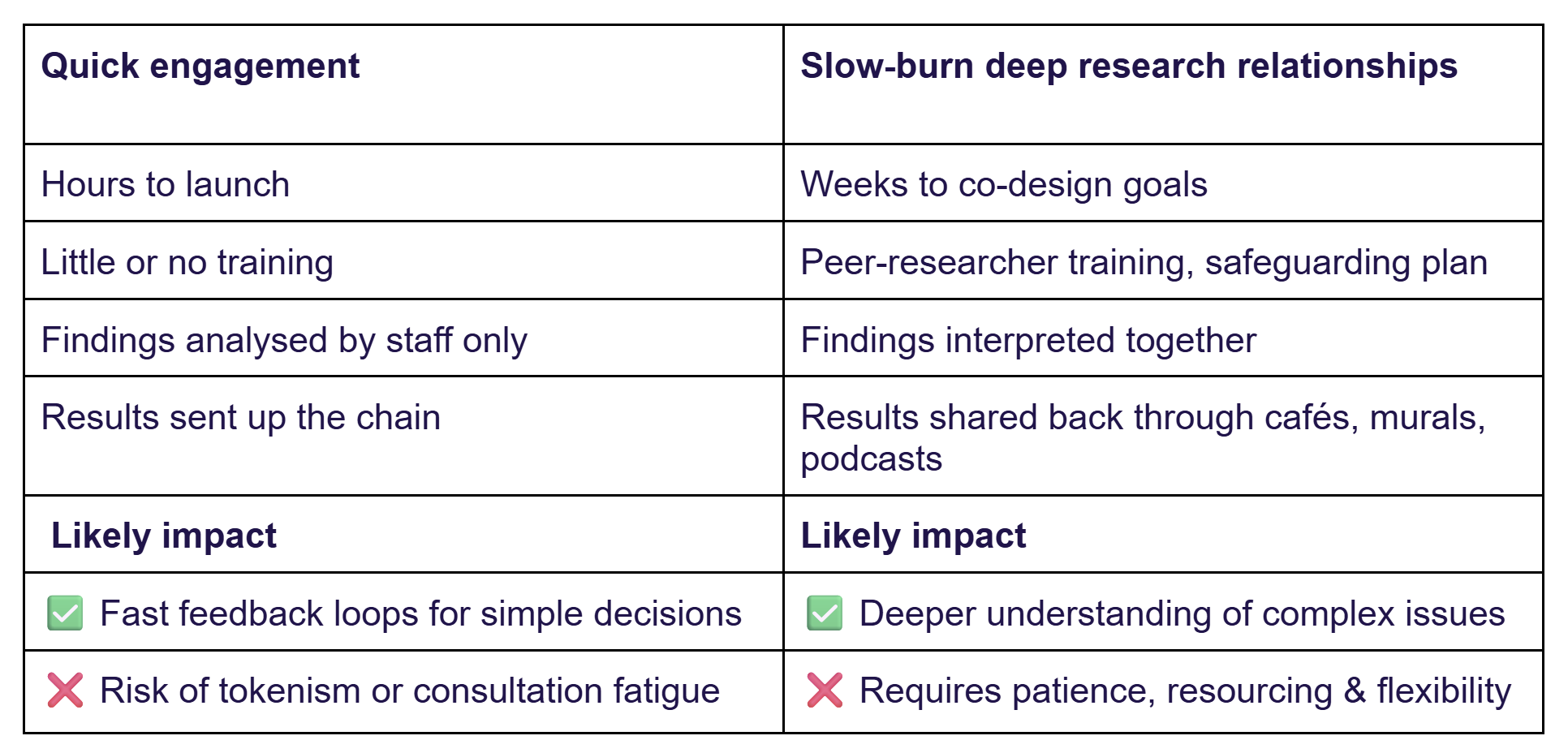Is it Research or Is it Community Engagement?”
3-minute read
This post is the first instalment in a four-part series exploring how community engagement and community-led research work together to shift power and create lasting change.
Earlier this month Habitus convened a trans-Atlantic panel of practitioners to tackle a deceptively simple question:
What really separates community engagement from community-led research?
And once we have that insight, how do we turn it into action that shifts power?
Why start here? Because funders increasingly ask for lived-experience involvement, yet many of us still feel uncertain: Have we done it well? Have we done it ethically? The conversation was candid, occasionally messy, and crucially, practical. The blog below distils the key ideas.
Power and Purpose: Who Decides, Who Benefits and Why it Matters?
Power surfaces early, sometimes invisibly. Conventional top down projects often begin with outside experts defining the problem, drafting the questions, choosing the methods and keeping the data in their own files. Community members and participants supply information; answer surveys or join focus groups, but they do not control how their information is used.
In community-led research the levers flip: people who live the issue help frame the questions, adapt the tools and co-author the story that comes out on the other side. That shift changes the purpose of the work from extracting answers to building relationships that help tackle the next questions.
“In traditional research we already know the questions, the methods, even the target population. Anything outside those parameters - we leave out.”
When people simply answer a survey, they rarely see where the data goes or how it changes anything. Community-led approaches invest time in trust-building so people co-shape both the inquiry and the follow-up action.
Prompt 1: Could community members veto, reshape or add a research question without asking permission? If not, the work leans toward traditional research rather than true co-production.
Many projects run on tight grants: collect data, hit the deadline, move on. That finite-game approach (clear goal, finish line, done) works for quick checks but struggles when the goal is long-term change.
Panellists pointed out that organisations sometimes “pat themselves on the back” for engagement that is little more than a pop-up poll. It feels participatory but nothing loops back.
Projects that aim to shift power treat research as an infinite game. Data still matters, yet the deeper aim is to weave networks of trust that can tackle whatever question comes next.
Community research, at its best, is:
Strategic: insights feed directly into programmes or policy, not a one-off report.
Long-term: the same people stay involved from idea to impact, avoiding “drive-by consultation.”
Reciprocal: findings, credit and resources return to the community.
In other words, the goal shifts from collecting answers to cultivating agency.
Prompt 2: If the final report were never published, would the community still gain something? If the answer is “yes,” then relationship rather than extraction is driving the work.
Why this distinction matters becomes obvious here:
Ethics: Extractive studies can reinforce inequities; participatory models redistribute power.
Quality: Data grounded in lived experience is often more accurate and actionable.
Sustainability: When people and communities help design the solutions, they’re invested in keeping them alive.
Co-production may feel like the future, but it won’t happen by accident. It requires time, it asks institutions to slow down, share control, and budget for relationship-building as a line item, not an afterthought.
Process and Practice: Speed vs Depth and the Five Pillars of Community Engagement
Fast feedback has value, sometimes you need a pulse check by Friday. Yet speed and depth rarely live in the same room. Light-touch tools spot surface issues but seldom reveal the “why.” Depth asks for time, skill-building and mutual care, signals that community knowledge is valued as highly as professional expertise.
“It can take months, multiple conversations, just to define the focus. But the result is rooted in trust and collaboration.”
Short surveys aren’t bad; they just shouldn’t be the end of the story. Done well, light-touch engagement can be the gateway into co-produced research.
You’ll recognise these ideas from “The Five Pillars of Community Engagement,” our practical roadmap for putting Respect, Reciprocity, Representation, Resourcing and Results into action. Overlay the pillars on power, purpose, and process and gaps appear quickly. A study might excel at Representation (diverse voices) yet stumble on Resourcing (no budget for follow-up). Using the pillars at kickoff and wrap-up keeps everyone honest when timelines tighten.
Moving from Checklist to Continuum
Research and engagement lie on one continuum:
Inform → Consult → Involve → Collaborate → Empower
Ask yourself:
Where are your current projects on that scale?
What would it take to move one step to the right?
Start small. Pair every quick survey with a follow-up discussion group, or invite community members onto your advisory or governance board. Over time those incremental shifts accumulate into a research culture that is genuinely community-powered.
Prompt 3: Now you’ve located where your project sits on the continuum, choose one element of your project (analysis, governance, sharing results) and identify where you can move a single step to the right.
Measuring, Maintaining and Rethinking Success
Classic metrics such as response rate, statistical significance, citation count still help, but communities often judge success by different lights:
Lasting relationships – the same people pick up your call for the next project.
True reflection – participants read the findings and say, “That sounds like us.
Staying power – recommendations survive staff changes and funding cycles.
When those signs improve, your project is delivering more than data; it is shifting power.
A starter checklist
Map who controls each decision; invite at least one community partner to co-own a major lever.
Set aside time and budget for check-ins six and twelve months after the report.
Pilot one depth tactic whether that be peer facilitation, shared data analysis or a community-written summary.
Test your design against the Five Pillars both at the start and the end.
Track relationship markers (return participation, shared ownership quotes) alongside standard KPIs.
Key Take-Aways
Ask with, not for: Let communities frame the questions.
Build reciprocity: Return findings and credit.
Invest in time: Sustainable change moves at the speed of trust.
Bottom line: Traditional research often starts by extracting answers, while community-led work begins by investing in relationships. The strongest projects move back and forth along that continuum, pairing robust methods with accountability to the people whose lives the findings will shape. Ultimately, labels matter less than power: who sets the agenda, who interprets the results, and who benefits. When that power shifts toward communities, information turns into impact.
Want More?
This piece captures highlights from a live Habitus webinar featuring Gbemi Babalola (Samaritans UK), Humaira Falak (United Way Calgary and Area), Lisa Elford (Habitus Canada) and Callum Ross (Habitus UK). Together they unpacked the practical and ethical tensions between “community engagement” and “community-led research.” You can watch the full webinar here.
If your organisation wants to move along the continuum; designing studies that share power, surface lived expertise and convert insights into lasting change, Habitus’ team specialises in end-to-end support for community research, engagement, and peer-led methodologies. Let’s build the next project together.
At Habitus, we have developed and designed successful community programmes for various charities, health organisations and businesses both in the UK and internationally.
We are accomplished in peer research, co-production, action-based and anti-oppressive research and evaluation. We are experts in helping organisations to engage wider community participation in their projects so that their work is more inclusive and impactful. Through this approach we are dedicated to increasing lived experience leadership.
Find out more about what we do by clicking the button below.



